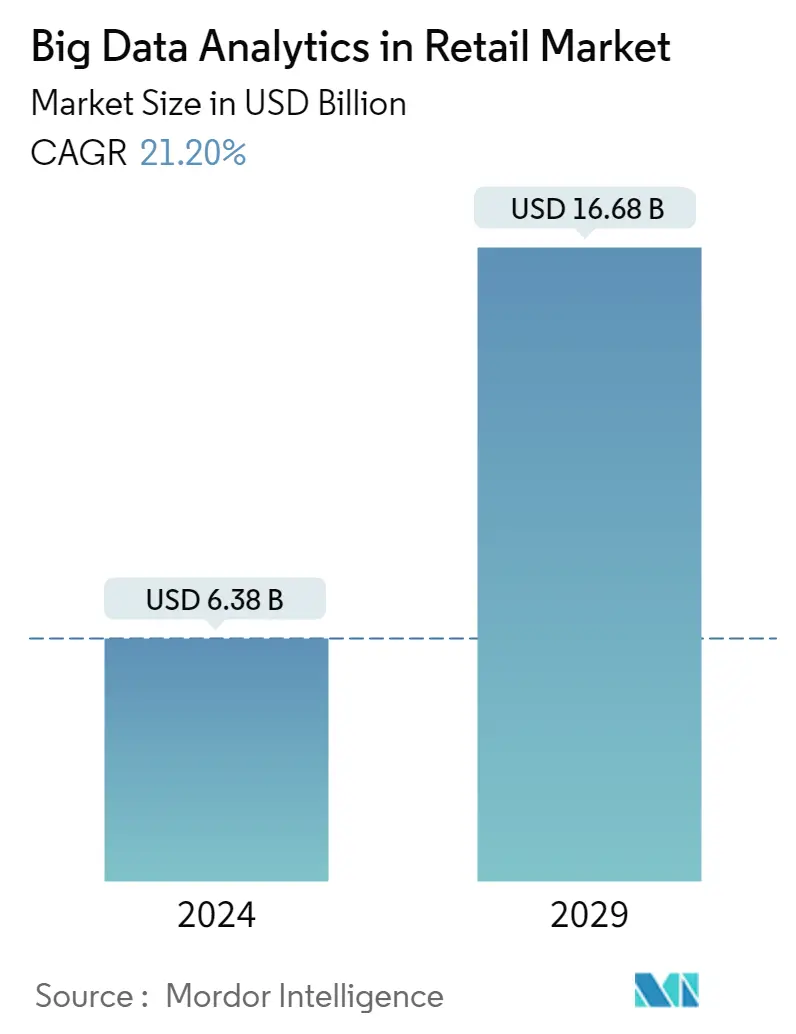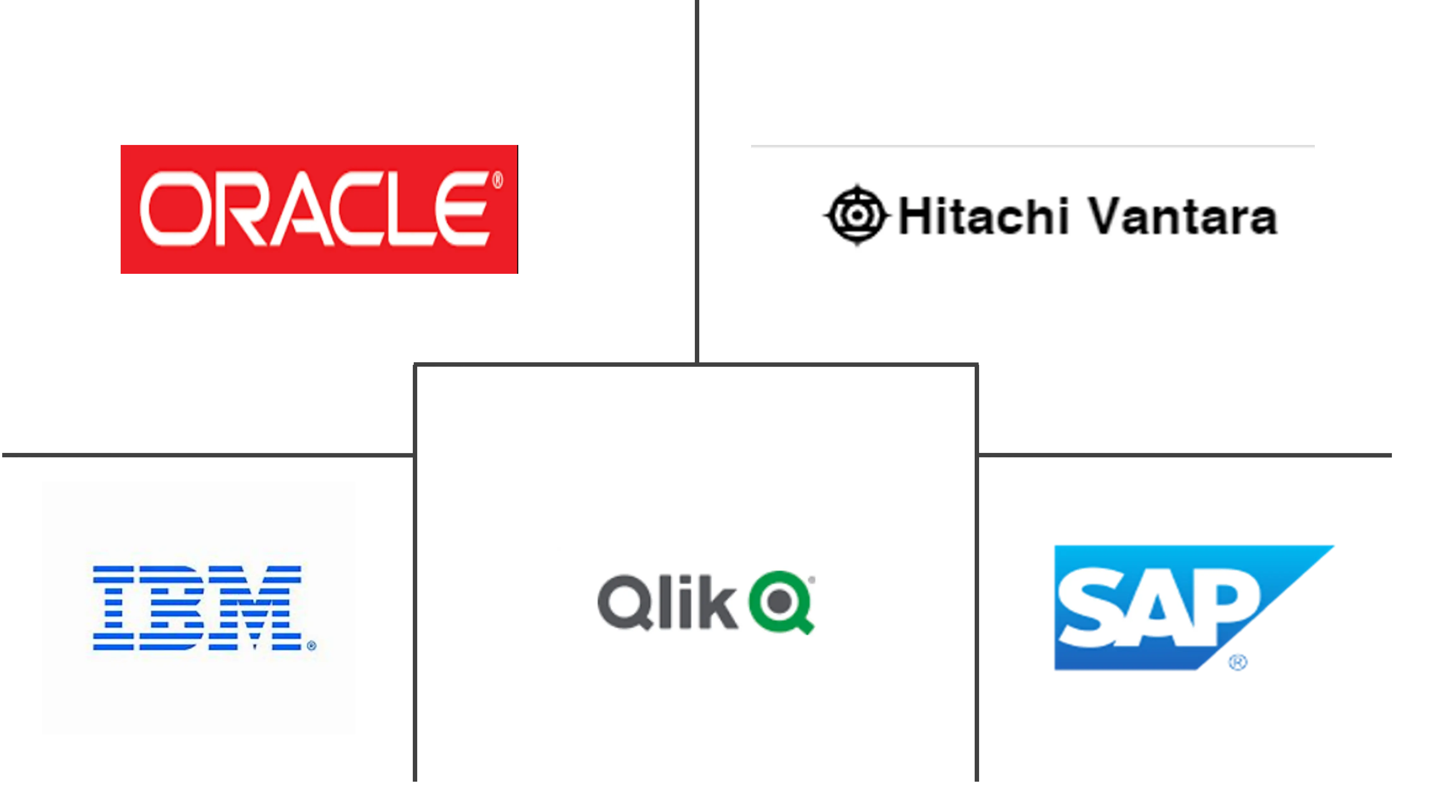Market Size of Big Data Analytics in Retail Industry

| Study Period | 2021 - 2029 |
| Market Size (2024) | USD 6.38 Billion |
| Market Size (2029) | USD 16.68 Billion |
| CAGR (2024 - 2029) | 21.20 % |
| Fastest Growing Market | Asia Pacific |
| Largest Market | North America |
| Market Concentration | Low |
Major Players
*Disclaimer: Major Players sorted in no particular order |
Big Data Analytics in Retail Market Analysis
The Big Data Analytics in Retail Market size is estimated at USD 6.38 billion in 2024, and is expected to reach USD 16.68 billion by 2029, growing at a CAGR of 21.20% during the forecast period (2024-2029).
The retail industry is witnessing a major transformation through advanced analytics and Big Data technologies. With the growth of e-commerce, online shopping, and high competition for customer loyalty, retailers are utilizing Big Data analytics to stay competitive in the market.
- The retail industry witnessed a steady adoption of cloud, AI, and related technologies and is considered one of the top sectors in terms of growth. According to a survey by NASSCOM, 70 percent of the companies said they focus on revenue growth by leveraging AI and increasing their spending. For Example, Walmart, one of the largest retailers in the world, is undergoing a digital transformation. It is in the process of building the world's largest private cloud system, which is expected to have the capacity to manage 2.5 petabytes of data every hour.
- Predictive analytics is a proactive approach whereby retailers can use data from the past to predict expected sales growth due to changes in consumer behaviors and market trends. It can help retailers stay ahead of the curve, compete effectively, and gain considerable market share. Increased Emphasis on Predictive Analytics which can help increase promotional effectiveness, drive cross-selling, and much more to build sustainable relationships with the customers.
- Retailers attempt to find innovative ways to draw insights from the ever-increasing amount of structured and unstructured information about consumer behavior. Retailers, both offline and online, are adopting the data-first strategy toward understanding their customers' buying behavior, mapping them to products, and planning marketing strategies to sell their products to increase profits by applying Big Data Analytics at every step of the retail process. Innovative ways such as Implementing IPS systems, Store Automation with self check out, Robots, and Automation in retail, etc., drive the need for Big data analytics in the retail market.
- Data integration challenges could restrain the market, including data governance, scalability, and problems associated with getting data from multiple sources to have data duplication and transformation rules. However, these can be reduced with the proper systematic set of rules.
- The COVID-19 pandemic hugely impacted retail markets at the regional and country level due to the shutdown of factories, and manufacturing plants, increase in prices, strict lockdowns, and supply chain disruptions as people's mobility were confirmed to their homes. However, post-pandemic considering the inherent human needs, Big Data is helping retailers to cater to customers in a more personalized way via targeted advertising, product recommendations, and pricing; the retailers increasingly prefer the technology.
Big Data Analytics in Retail Industry Segmentation
Big Data analytics is used at every retail stage to understand customer behavior, predict demand, and optimize pricing. In terms of application, Big data offers machine learning and artificial intelligence algorithms that can speed up business decision-making, discover patterns in data sets and optimize and streamline business processes to fatten up those thin margins in the retail sector.
The Big Data Analytics in the Retail Market is segmented by Application ( Merchandising and Supply Chain Analytics, Social Media Analytics, Customer Analytics, Operational Intelligence, and Other Applications), Business Type (Small and Medium Enterprises, Large-scale Organizations), and Geography. The market sizes and forecasts are provided in terms of value (USD billion) for all the above segments.
| By Application | |
| Merchandising and Supply Chain Analytics | |
| Social Media Analytics | |
| Customer Analytics | |
| Operational Intelligence | |
| Other Applications |
| By Business Type | |
| Small and Medium Enterprises | |
| Large-scale Organizations |
| Geography | |
| North America | |
| Europe | |
| Asia-Pacific | |
| Rest of the World |
Big Data Analytics in Retail Market Size Summary
The Big Data Analytics in Retail Market is undergoing a significant transformation, driven by the increasing adoption of advanced analytics and Big Data technologies. As e-commerce and online shopping continue to expand, retailers are leveraging these technologies to maintain competitiveness and enhance customer loyalty. The integration of cloud, AI, and related technologies has positioned the retail sector as a leading area of growth. Companies like Walmart are at the forefront of this digital transformation, building extensive private cloud systems to manage vast amounts of data. Predictive analytics plays a crucial role in this evolution, enabling retailers to anticipate sales growth by analyzing past consumer behaviors and market trends. This proactive approach helps retailers improve promotional effectiveness, drive cross-selling, and foster sustainable customer relationships. Despite challenges such as data integration and governance, the strategic application of Big Data Analytics is reshaping the retail landscape, particularly in supply chain optimization and personalized customer engagement.
In North America, the Big Data Analytics market in retail is experiencing robust growth, fueled by the demand for retail analytics tools and the adoption of IoT technologies. The region's strong retail industry, coupled with high consumer confidence and a resilient economy, supports this expansion. North America is a leader in Big Data analytics adoption, with a strong presence of vendors like IBM, SAS Institute, and Alteryx, contributing to market growth. The digitization and automation of retail processes under Industry 4.0 are further propelling market development. The competitive landscape is characterized by high rivalry and fragmentation, with significant opportunities arising from e-commerce and customer loyalty competition. Innovations and strategic partnerships, such as those by Maxis and DataWeave, are enhancing market dynamics, while acquisitions like Coresight Research's purchase of Alternative Data Analytics are expanding data capabilities. These developments underscore the critical role of Big Data Analytics in driving efficiency, personalization, and strategic decision-making in the retail sector.
Big Data Analytics in Retail Market Size - Table of Contents
-
1. MARKET DYNAMICS
-
1.1 Market Overview
-
1.2 Market Drivers
-
1.2.1 Increased Emphasis on Predictive Analytics
-
1.2.2 Merchandising and Supply Chain Analytics Segment Expected to Hold Significant Share
-
-
1.3 Market Restraints
-
1.3.1 Complexities in Collecting and Collating the Data From Disparate Systems
-
-
1.4 Industry Value Chain Analysis
-
1.5 Industry Attractiveness - Porter Five Forces
-
1.5.1 Threat of New Entrants
-
1.5.2 Bargaining Power of Buyers/Consumers
-
1.5.3 Bargaining Power of Suppliers
-
1.5.4 Threat of Substitute Products
-
1.5.5 Intensity of Competitive Rivalry
-
-
1.6 Impact of COVID-19 on the Market
-
-
2. MARKET SEGMENTATION
-
2.1 By Application
-
2.1.1 Merchandising and Supply Chain Analytics
-
2.1.2 Social Media Analytics
-
2.1.3 Customer Analytics
-
2.1.4 Operational Intelligence
-
2.1.5 Other Applications
-
-
2.2 By Business Type
-
2.2.1 Small and Medium Enterprises
-
2.2.2 Large-scale Organizations
-
-
2.3 Geography
-
2.3.1 North America
-
2.3.2 Europe
-
2.3.3 Asia-Pacific
-
2.3.4 Rest of the World
-
-
Big Data Analytics in Retail Market Size FAQs
How big is the Big Data Analytics in Retail Market?
The Big Data Analytics in Retail Market size is expected to reach USD 6.38 billion in 2024 and grow at a CAGR of 21.20% to reach USD 16.68 billion by 2029.
What is the current Big Data Analytics in Retail Market size?
In 2024, the Big Data Analytics in Retail Market size is expected to reach USD 6.38 billion.

